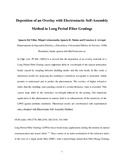Deposition of an overlay with electrostactic self-assembly method in long period fiber gratings
Fecha
2005Autor
Versión
Acceso abierto / Sarbide irekia
Tipo
Artículo / Artikulua
Versión
Versión aceptada / Onetsi den bertsioa
Impacto
|
|
10.1364/OL.30.000720
Resumen
It was proved that the deposition of an overlay material onto a long-period fiber grating causes important
shifts in the wavelengths of the typical attenuation bands that are caused by coupling between cladding and
core modes [Opt. Lett. 27, 682 (2002)]. A theoretical model for analyzing a multilayer cylindrical waveguide
is presented that permits the phenomenon to be understood and predicted. ...
[++]
It was proved that the deposition of an overlay material onto a long-period fiber grating causes important
shifts in the wavelengths of the typical attenuation bands that are caused by coupling between cladding and
core modes [Opt. Lett. 27, 682 (2002)]. A theoretical model for analyzing a multilayer cylindrical waveguide
is presented that permits the phenomenon to be understood and predicted. An overlay of higher refractive
index than the cladding starts to guide a mode if a certain thickness value is exceeded. This causes large
shifts in the resonance wavelength induced by the grating. One important application of this phenomenon to
sensors is enhancement of the sensitivity of a long-period fiber grating to ambient conditions. Theoretical
results are corroborated with experimental ones obtained by electrostatic self-assembly. [--]
Materias
Long period fiber Bragg gratings,
Optical fiber sensors,
Thin-films,
Coupled-mode theory
Editor
Optical Society of America
Publicado en
Optics Letters Vol. 30, Issue 7, pp. 720-722 (2005)
Departamento
Universidad Pública de Navarra. Departamento de Ingeniería Eléctrica y Electrónica /
Nafarroako Unibertsitate Publikoa. Ingeniaritza Elektrikoa eta Elektronikoa Saila
Versión del editor
Entidades Financiadoras
This research was supported by Spanish Comisíon
Interministerial de Ciencia y Tecnología research
grant TIC 2003-00909, by the Gobierno de Navarra,
and by the Formacion de Profesorado Universitario
Ministerio de Educacion Cultura y Deporte fellow-
ships.





